Coburn J.W. Algebra and Trigonometry
Подождите немного. Документ загружается.


980 CHAPTER 10 Analytic Geometry and the Conic Sections 10-62
The last two equations can be written as a system, which we will use to solve for
x and y in terms of X and Y.
original system
multiply second equation by
factor out
Re-solving the system for y results in yielding what are
called the rotation of axes formulas (see Exercise 79).
Rotation of Axes Formulas
If the x- and y-axes of the xy-plane are rotated counterclockwise by the (acute) angle
to form the X- and Y-axes of an XY-plane, the coordinates of the points (x, y) and
(X, Y) are related by the formulas
EXAMPLE 2
Naming the Location of a Point After Rotating the Axes
Given the point in the xy-plane, find the coordinates of this point in the
XY-plane given the angle between the xy-axes and the XY-axes is
Solution
Using the formulas with and we obtain
The coordinates of P(X, Y) would be (2, 0).
Now try Exercises 9 through 16
The diagram in Figure 10.51 pro-
vides a more intuitive look at the rotation
from Example 2. As you can see, a
30-60-90 triangle is formed with a
hypotenuse of 2, giving coordinates
(2, 0) in the XY-plane.
0 2
13
2
13
2
a
1
2
b 13 a
13
2
b
1 sin 60° 13
cos 60° 1 cos 60° 13 sin 60°
Y x sin y cos X x cos y sin
60°,x 1, y 13
,
60°.
11, 13
2
Y x sin y cos y X sin Y cos
X x cos y sin x X cos Y sin
y X sin Y cos ,
x 1cos
2
sin
2
12X cos Y sin x
first equation second equation
X cos Y sin x cos
2
x sin
2
sin
e
X cos x cos
2
y sin cos
Y sin y sin cos x sin
2
e
X x cos y sin
Y y cos x sin
y cos x sin x cos y sin
r sin cos r cos sin r cos cos r sin sin
r1sin cos cos sin 2 r1cos cos sin sin 2
Y r sin1 2 X r cos1 2
WORTHY OF NOTE
If you are familiar with
matrices, it may be easier to
remember the rotation
formulas in their matrix form,
since the pattern of functions
is the same, with only a
difference in sign:
See Exercises 86 and 87.
c
x
y
dc
cos sin
sin cos
dc
X
Y
d
c
X
Y
dc
cos sin
sin cos
dc
x
y
d
x
y
XY-plane: (2, 0)
X
Y
xy-plane: (1, √3)
√3
60
1
Figure 10.51
multiply first equation by cos
cob19529_ch10_0979-0994.qxd 12/6/08 12:49 AM Page 980 epg HD 049 :Desktop Folder:Satya 05/12/08:

10-63 Section 10.6 More on the Conic Sections: Rotation of Axes and Polar Form 981
College Algebra & Trignometry—
EXAMPLE 3
Writing the Equation of a Conic After Rotating the Axes
The ellipse is rotated clockwise What is the corresponding
equation in the xy-plane?
Solution
We proceed as before, using the rotation formulas and
With we have yielding
use rotation formulas
substitute for and
square binomials
distribute
result
Now try Exercises 17 through 20
Note the equation of the conic in the standard xy-plane contains the “mixed” Bxy-
term. In practice, we seek to reverse this procedure by starting in the xy-plane, and
finding the angle needed to eliminate the Bxy-term. Using the rotation formulas and
the appropriate angle the equation
becomes where the xy-term is absent. To find the
angle note that without loss of generality, we can assume since only the
second-degree terms are used to identify a conic. Starting with the simplified equation
and using the rotation formulas we obtain
Expanding this expression and collecting like terms (see Exercise 80), gives the
following expressions for coefficients a, b, and c of the corresponding equation
a is the coefficient of X
2
b is the coefficient of XY
c is the coefficient of Y
2
(the constant
remains unchanged)
To accomplish our purpose, we require the coefficient b to be zero. While this
expression looks daunting, the double-angle identities for sine and cosine simplify it
very nicely:
(1)
(2)
(3)
(4)
(5)
tan122
B
A C
; A C
tan122
B
C A
1C A2sin122B cos122
A sin122 B cos122 C sin(2) 0
b S A12 sin cos 2 B1cos
2
sin
2
2 C12 sin cos 2 0
f Ff S F
c S A sin
2
B sin cos C cos
2
b S 2A sin cos B1cos
2
sin
2
2 2C sin cos
a S A cos
2
B sin cos C sin
2
aX
2
bXY cY
2
f 0:
A1X cos Y sin 2
2
B1X cos Y sin 21X sin Y cos 2 C1X sin Y cos 2
2
F 0
F 0Cy
2
y
#
BxAx
2
Ax
2
Bxy Cy
2
F 0
D E 0,
aX
2
cY
2
dX eY f 0,
Ax
2
Bxy Cy
2
Dx Ey F 0,
5
2
x
2
3xy
5
2
y
2
16
1
2
x
2
xy
1
2
y
2
2x
2
4xy 2y
2
16
a
1
2
x
2
xy
1
2
y
2
b 4a
1
2
x
2
xy
1
2
y
2
b 16
cos sin
12
2
a
12
2
x
12
2
yb
2
4a
12
2
y
12
2
xb
2
16
1x cos y sin 2
2
41y cos x sin 2
2
16
X
2
4Y
2
16
cos sin
12
2
, 45°Y y cos x sin .
X x cos y sin
45°.X
2
4Y
2
16
cob19529_ch10_0979-0994.qxd 12/6/08 12:49 AM Page 981 epg HD 049 :Desktop Folder:Satya 05/12/08:

982 CHAPTER 10 Analytic Geometry and the Conic Sections 10-64
College Algebra & Trignometry—
Note from line (3) that would imply giving or
, with or (for the sake of convenience, we select the angle in QI).
This fact can many times be used to great advantage. If and
we choose between 0 and so that will be in the first quadrant
The Equation of a Conic After Rotating the Axes
For a conic defined by and its graph in the
xy-plane, an angle can be determined using and used in the
rotation formulas to find a polynomial in XY-plane,
where the conic is either vertical or horizontal.
EXAMPLE 4
Rotating the Axes to Eliminate the Bxy-Term
For eliminate the xy-term using a
rotation of axes and identify the conic associated with the resulting equation. Then
sketch the graph of the rotated conic in the XY-plane.
Solution
Since we find using , giving
This shows yielding so Using
and along with the rotation formulas we obtain the following
XY-equation, with corresponding terms shown side-by-side for clarity:
Given Term in xy-Plane Corresponding Term in xy-Plane
16
16
a
1
2
X
13
2
Yb
1
2
X
13
2
Y y
13
a
13
2
X
1
2
Yb
3
2
X
13
2
Y 13x
3a
1
2
x
13
2
Yb
2
3
4
X
2
3
13
2
XY
9
4
Y
2
3y
2
213a
13
2
X
1
2
Yba
1
2
X
13
2
Yb
3
2
X
2
13XY
3
2
Y
2
213xy
a
13
2
X
1
2
Yb
2
3
4
X
2
13
2
XY
1
4
Y
2
x
2
sin 30°
1
2
cos 30°
13
2
30°.2 60°2 tan
1
13,
tan122
213
1 3
13.tan122
B
A C
A C,
x
2
213xy 3y
2
13x y 16 0,
aX
2
cY
2
dX eY f 0
tan122
B
A C
Ax
2
Bxy Cy
2
Dx Ey F 0
30 6 6 90°4.
180°2
A C, tan122
B
A C
45° 45°90°
2 90°cos122 0,A C
→
→
→
→
→
→
cob19529_ch10_0979-0994.qxd 01/14/2009 03:19 PM Page 982 ssen 1 HD 049:Desktop Folder:Satya 14/01/09:Used file:MHDQ092-10:

10-65 Section 10.6 More on the Conic Sections: Rotation of Axes and Polar Form 983
College Algebra & Trignometry—
Adding the like terms to the far right, the X
2
-terms
(in red), the Y-terms (in bold), and the mixed XY-
terms (in blue) sum to zero, leaving the equation
which is the parabola
defined by This parabola is
symmetric to the X-axis and opens to the right,
with a vertex at ( ), Y-intercepts at ( )
and (0, 2), focus at and directrix
through . The graph is shown in the
figure.
Now try Exercises 21 through 30
In Example 4, the angle was a standard angle and easily found. In general, this is
not the case and finding exact values of and for use in the rotation formulas
requires using the corresponding (triangle) diagram, and the iden-
tities and . See Exercises 31, 32, 84,
and 85 for further study.
B. Identifying Conics Using the Discriminant
In addition to rotating the axes, the inclusion of the “xy-term” makes it impossible to
identify the conic section using the tests seen earlier. For example, having no
longer guarantees a circle, and or does not guarantee a parabola. Rather
than continuing to look at what the mixed term and the resulting rotation changes, we
now look at what the rotation does not change, called invariants of the transforma-
tion. These invariants can be used to double-check the algebra involved and to iden-
tify the conic using the discriminant. These are given here without proof.
Invariants of a Rotation and Classification Using the Discriminant
By rotating the coordinate axes through a predetermined angle
the equation
can be transformed into
in which the xy-term is absent. This rotation has the following invariants:
(1) (2) (3)
The discriminant of a conic equation in polynomial form is Except in
degenerate cases, the graph of the equation can be classified as follows:
If the graph will be a parabola.
If the graph will be a circle or an ellipse.
If the graph will be a hyperbola.B
2
4AC 7 0,
B
2
4AC 6 0,
B
2
4AC 0,
B
2
4AC.
B
2
4AC b
2
4ac.A C a cF f
aX
2
cY
2
dX eY f 0
Ax
2
Bxy Cy
2
Dx Ey F 0
,
C 0A 0
A C
sin
A
1 cos122
2
cos
B
1 cos122
2
tan122
sin122
cos122
,
sin cos
1
65
8
, 02
1
63
8
, 02
0, 28, 0
Y
2
1
2
1X 82.
2X 4Y
2
16 0,
x
y
Y
X
30
(0, 2)
(8, 0)
(0, 2)
A. You’ve just learned how
to graph conic sections that
have nonvertical and nonhori-
zontal axes (rotated conics)
cob19529_ch10_0979-0994.qxd 12/6/08 12:49 AM Page 983 epg HD 049 :Desktop Folder:Satya 05/12/08:
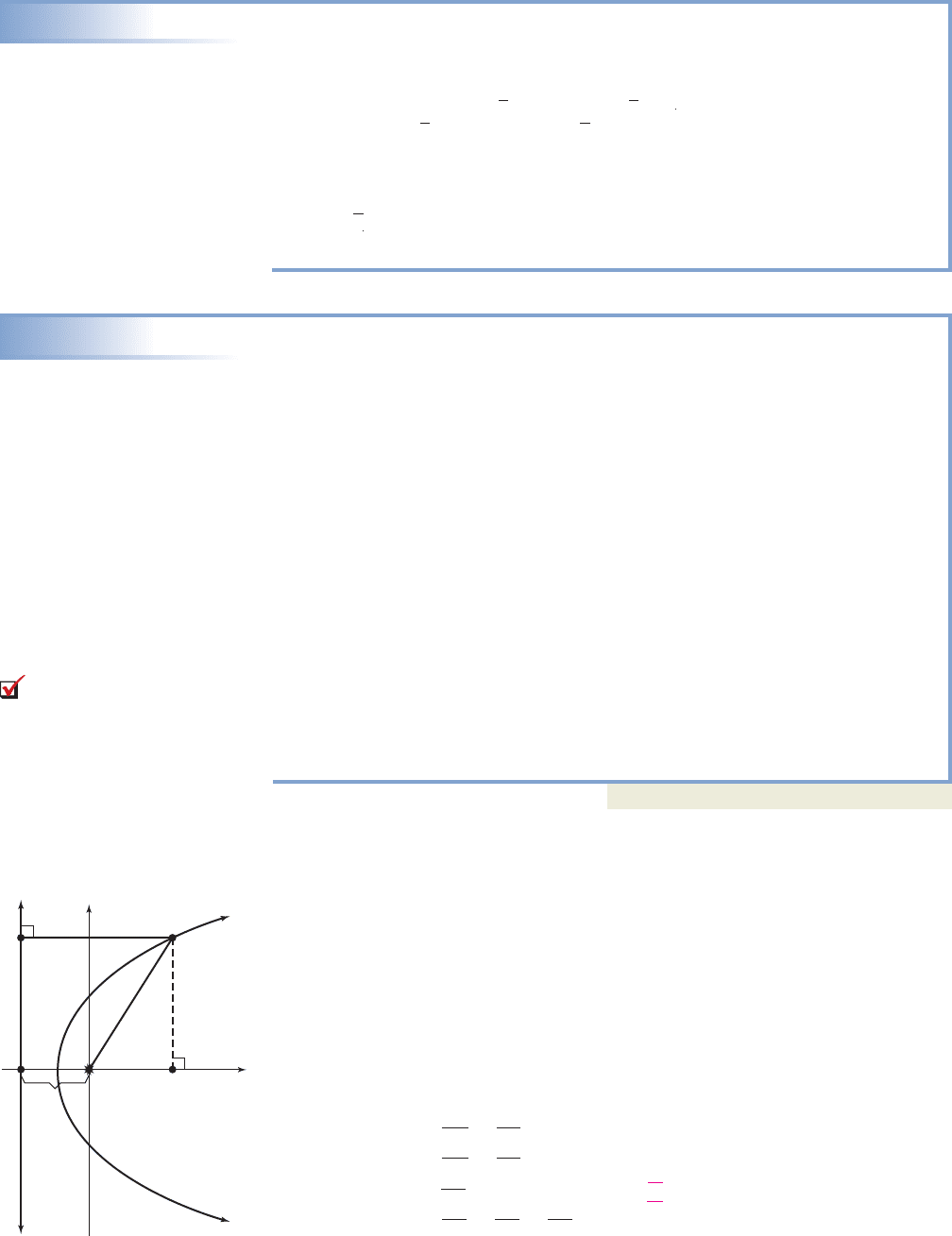
984 CHAPTER 10 Analytic Geometry and the Conic Sections 10-66
College Algebra & Trignometry—
EXAMPLE 5A
Verifying the Invariants of a Rotation of Axes
Verify the invariants just given using the equations from Example 4. Also verify
the discriminant test.
Solution
From the equation we have
and After
applying the rotation the equation became with
and . Checking each
invariant gives (1)
✓, (2) ✓, and
(3)
✓. With
the discriminant test indicates the conic is a parabola ✓.
EXAMPLE 5B
Identifying the Equation of a Conic Using the Discriminant
Use the discriminant to identify each equation as that of a circle, ellipse, parabola,
or hyperbola, but do not graph the equation.
a.
b.
c.
d.
Solution
a. b.
circle or ellipse hyperbola
c. d.
hyperbola parabola
Now try Exercises 33 through 36
C. Conic Equations in Polar Form
You might recall that earlier in this chapter we defined ellipses and hyperbolas in terms
of a distance between two points, but a parabola in terms of a distance between a point
and a line (the focus and directrix). Actually, all conic sections can be defined using a
focus/directrix development and written in polar form. This serves to unify and greatly
simplify their study. We begin by revisiting the focus/directrix development of a
parabola, using a directrix l and placing the focus at the origin. With the polar axis as
the axis of symmetry and the point in polar coordinates, we obtain the graph
shown in Figure 10.52. Given D and A are points on l (with A on the polar axis), we
note the following:
(1)
definition of a parabola
(2) equal line segments
(3)
(4)
sum of line segmentsAB AF FB
cos
FB
r
FB r cos
DP
AB
DP FP
P1r, 2
0 25
B
2
4AC 162
2
4112192 B
2
4AC 172
2
4162112
A 1; B 6; C 9 A 6; B 7; C 1
17 20
B
2
4AC 192
2
4142142 B
2
4AC 142
2
4132132
A 4; B 9; C 4 A 3; B 4; C 3
x
2
6xy 9y
2
6x 0
6x
2
7xy y
2
5 0
4x
2
9xy 4y
2
8x 24y 9 0
3x
2
4xy 3y
2
6x 12y 2 0
B
2
4AC 0,12132
2
4112132 102
2
4102142
1 3 0 416 16
f 16a 0, b 0, c 4, d 2, e 0,
2X 4Y
2
16 0,
F 16.A 1, B 213
, C 3, D 13, E 1,
x
2
213xy 3y
2
13x y 16 0,
B. You’ve just learned how
to identify conics using the
discriminant of the polynomial
form—the invariant B
2
4AC
Figure 10.52
r
d
F(0, 0) BA
ᏸ
D
P(
r, )
Directrix
y
x
cob19529_ch10_0979-0994.qxd 12/6/08 12:49 AM Page 984 epg HD 049 :Desktop Folder:Satya 05/12/08:
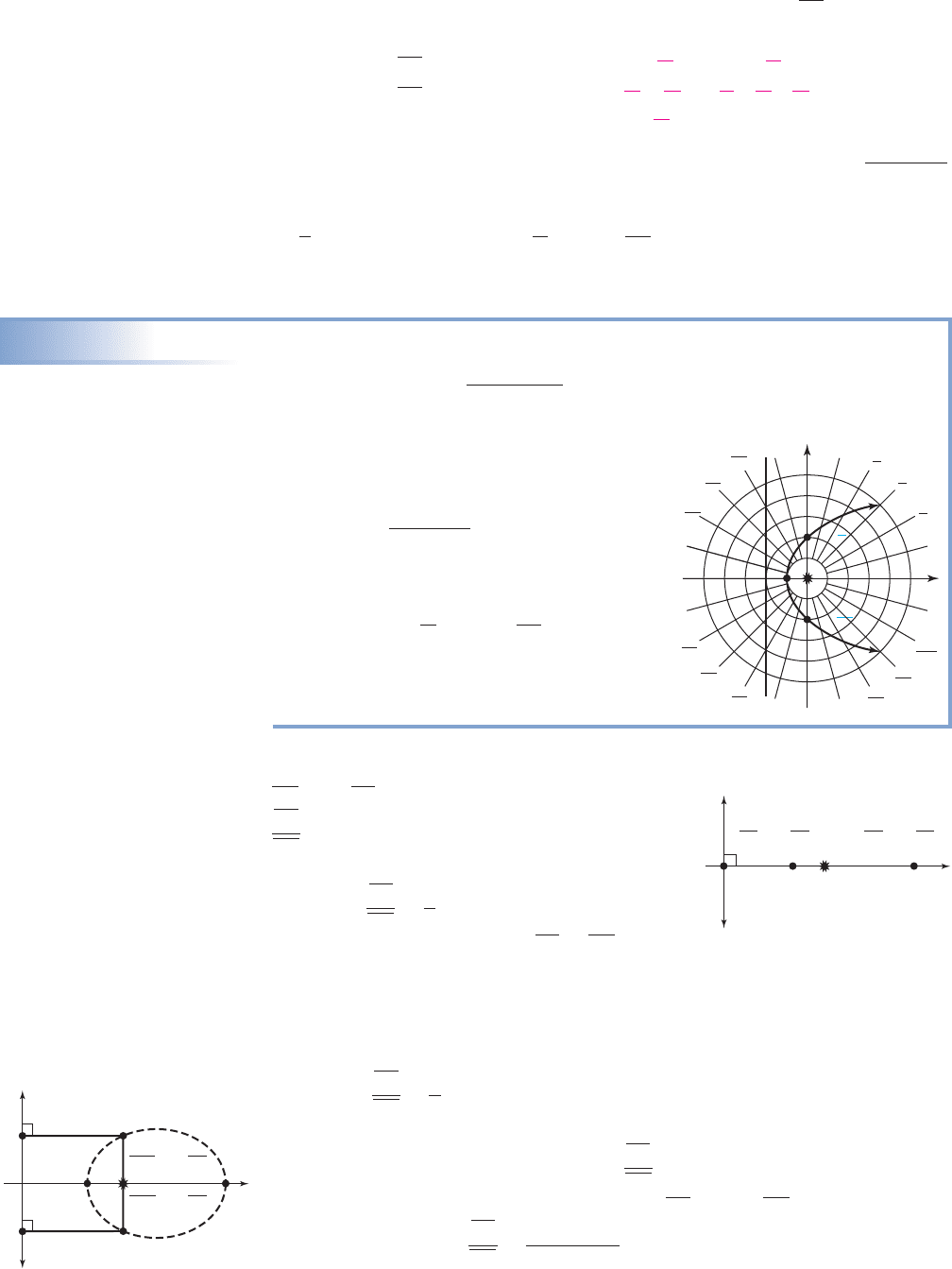
10-67 Section 10.6 More on the Conic Sections: Rotation of Axes and Polar Form 985
College Algebra & Trignometry—
Using the preceding equations and representing the distance by the constant
d, we obtain this sequence:
substitute d for and for
substitute for since
substitute r for
Solving the last equation for r we have then
which is the equation of a parabola in polar form with its focus at the origin, vertex at
and y-intercepts at and . Note the constant “1” in the denom-
inator is a key characteristic of polar equations, and helps define the standard form.
EXAMPLE 6A
Identifying a Conic from Its Polar Equation
Verify the equation represents a parabola, then describe and
sketch the graph.
Solution
Write the equation in standard form by
dividing the numerator and denominator by 3,
obtaining . From this we see
and the represents a parabola symmetric
to the polar axis, with vertex at ( ) and
y-intercepts at and , as shown
in the figure.
The polar equation for a parabola depended on
and being equal in length, with ratio
But what if this ratio is not equal to 1?
Similar to our introduction to conics in Section 10.1,
we assume and investigate the graph that
results.Cross-multiplying gives which states that the distance from D to P
is twice the distance from F to P. Note that we are able to locate two points P
1
and P
2
on the polar axis that satisfy this relation, rather than only one as in the case of the
parabola. Figure 10.53 illustrates the location of these points. Using the focal chord
for convenience, two additional points P
3
and P
4
can be located that also satisfy the
stated condition (see Figure 10.54). In fact, we can locate an infinite number of these
points using and the resulting graph appears to be an ellipse (and is definitely
not aparabola). These illustrations provide the basis for stating a general focus/directrix
definition of the conic sections. The ratio is often represented by the letter e,
and represents the eccentricityof the conic. Using and from
our initial development, which enables us to state the general
FP
DP
r
d r cos
e,
DP
d r cos FP r
FP
DP
FP
DP
1
2
,
2FP
DP,
FP
DP
1
2
FP
DP
1.
FP
DP
a2,
3
2
ba2,
2
b
1,
d 2
r
2
1 cos
r
6
3 3 cos
ad,
3
2
bad,
2
ba
d
2
, b,
r
d
1 cos
,r r cos d,
FPr d r cos
FP DP ABABFPFP d r cos
FBr cos AFAB d r cos
AF
(2, )
3
4
3
4
6
3
2
3
4
2
3
5
6
7
6
5
4
4
3
5
3
7
4
11
6
2
(2, )
(1,)
ᏸ
D
P
1
P
2
F
ᏸ
DP
1
2FP
1
DP
2
2FP
2
Directrix
Figure 10.53
P
1
P
4
D
1
D
2
P
3
P
2
F
ᏸ
D
1
P
3
2FP
3
D
2
P
4
2FP
4
Figure 10.54
cob19529_ch10_0979-0994.qxd 12/6/08 12:49 AM Page 985 epg HD 049 :Desktop Folder:Satya 05/12/08:
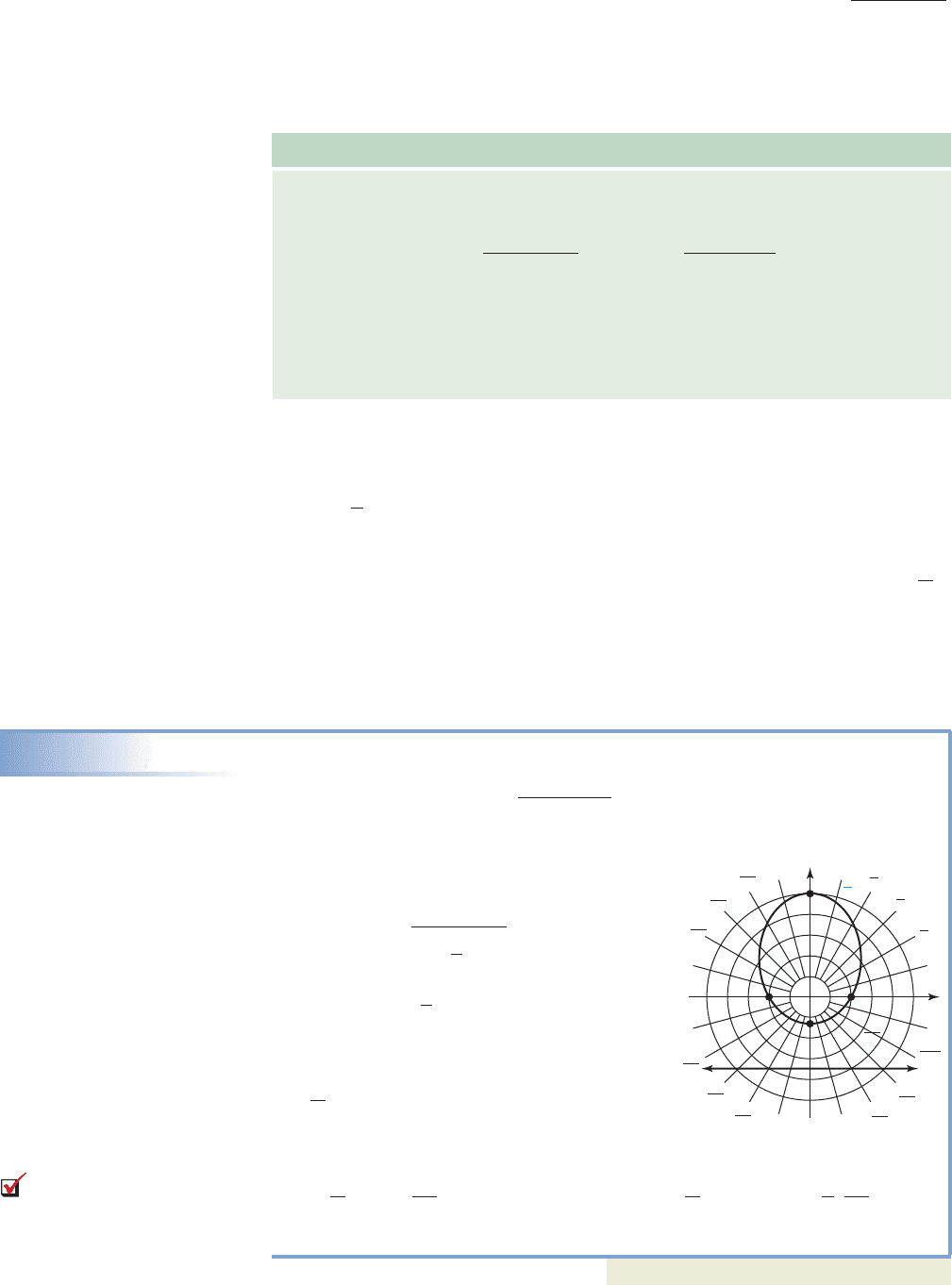
986 CHAPTER 10 Analytic Geometry and the Conic Sections 10-68
College Algebra & Trignometry—
equation of a conic in polar form. Solving for r leads to the equation
where the type of conic depends solely on e. Depending on the orientation of the conic,
the general form may involve sine instead of cosine, and have a sum of terms in the
denominator rather than a difference. Note once again that if the relation sim-
plifies into the parabolic equation seen earlier.
The Standard Equation of a Conic in Polar Form
Given a conic section with eccentricity e, one foci at the pole of the
-plane
, and
directrix l located d units from this focus. Then the polar equations
and
represent one of the conic sections as determined by the value of e.
• If the graph is a parabola.
• If the graph is an ellipse.
• If the graph is a hyperbola.
For the ellipse and hyperbola, the major axis and transverse axis (respectively)
are both perpendicular to the directrix and contain the vertices and foci. Our
earlier development of eccentricity can then be expressed in terms of a and c, as the
ratio
As in our previous study of polar equations, if the equation involves cosine the
graph will be symmetric to the polar axis. If the graph involves sine, the line is
the axis of symmetry. In addition, if the denominator contains a difference of terms (as
in Example 6A), the graph will be above or to the right of the directrix (depending on
whether the equation involves sine or cosine). If the denominator contains a sum of
terms, the graph will be below or to the left of the directrix.
EXAMPLE 6B
Using the Standard Equation to Graph a Conic in Polar Form
Determine if the equation represents a parabola, ellipse, or
hyperbola. Then describe and sketch the graph.
Solution
To write the equation in standard form, we divide
both numerator and denominator by 5, obtaining
the equation From the standard
form we note so the equation represents an
ellipse. With a difference of terms and the sine
function involved, the graph is symmetric to
and is above the directrix. Given so much
information by the equation, we require very few
points to sketch the graph and settle for those generated by
and yielding the points (2, 0), and The
graph is shown in the figure.
Now try Exercises 37 through 56
a
5
4
,
3
2
b.a5,
2
b, 12, 2,
3
2
, 0,
2
, ,
2
e
3
5
r
2
1
3
5
sin
.
r
10
5 3 sin
2
e
c
a
.
e 7 1,
0 6 e 6 1,
e 1,
r
de
1 e sin
r
de
1 e cos
r
e 1,
r
de
1 e cos
,
2
(2, )
(2, 0)
ᏸ
3
4
3
4
6
2
3
3
4
5
6
7
6
5
4
4
3
5
3
7
4
11
6
2
(5, )
(1.25, )
3
2
1
C. You’ve just learned how
to write the equation of a
conic section in polar form
cob19529_ch10_0979-0994.qxd 12/6/08 12:49 AM Page 986 epg HD 049 :Desktop Folder:Satya 05/12/08:
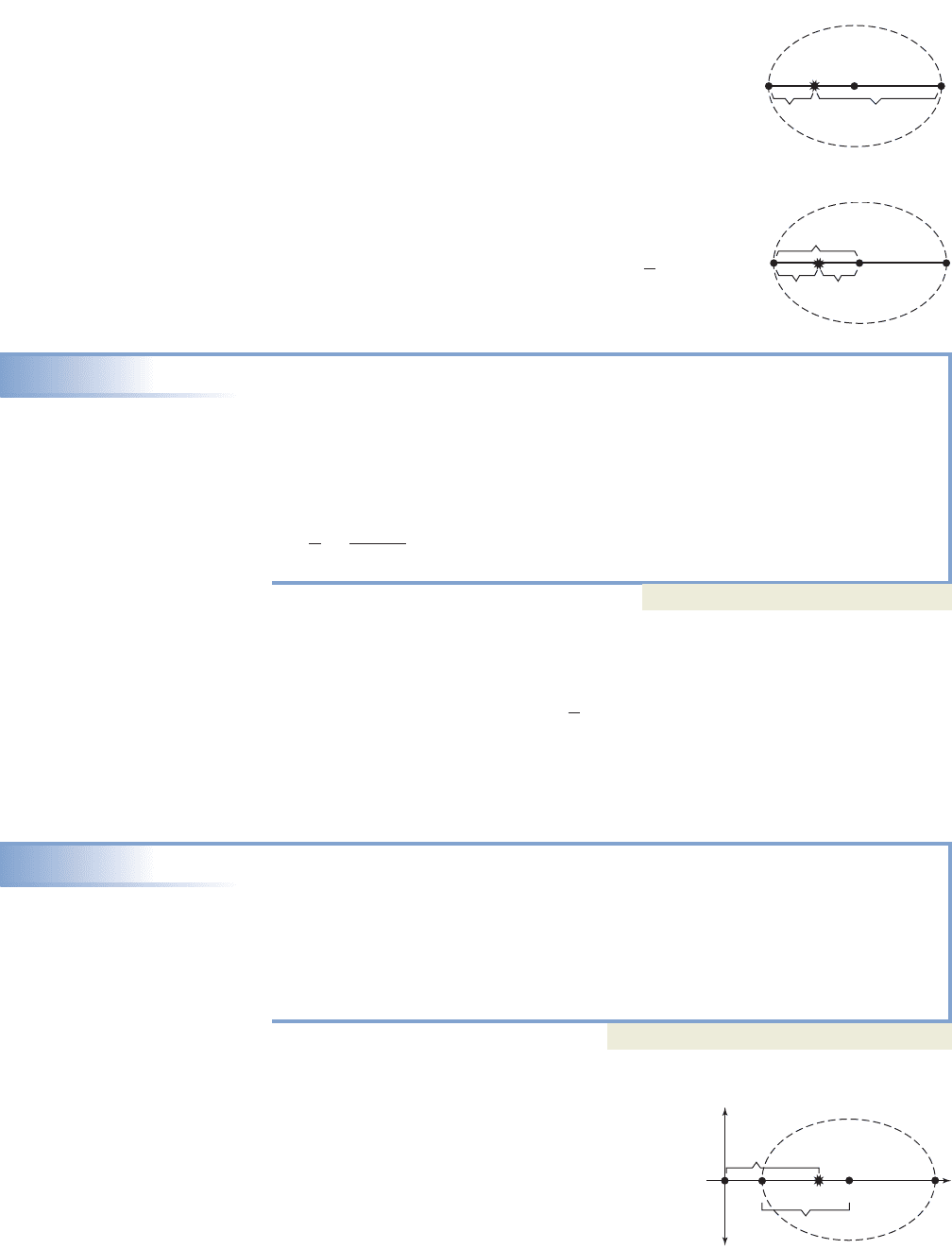
10-69 Section 10.6 More on the Conic Sections: Rotation of Axes and Polar Form 987
College Algebra & Trignometry—
D. Applications of Conics in Polar Form
For centuries it has been known that the orbits of the planets
around the Sun are elliptical, with the Sun at one focus. In
addition, comets may approach our Sun in an elliptical,
hyperbolic, or parabolic path with the Sun again at the foci.
This makes planetary studies a very natural application of
the conic sections in polar form. To aid this study, it helps
to know that in an elliptical orbit, the maximum distance of
a planet from the Sun is called its aphelion, and the short-
est distance is the perihelion(Figure 10.55). This means the
length of the major axis is “aphelion perihelion,” enabling
us to find the value of c if the aphelion and peri-
helion are known (Figure 10.56). Using , we can
then find the eccentricity of the planet’s orbit.
EXAMPLE 7
Determining the Eccentricity of a Planet’s Orbit
In its elliptical orbit around the Sun, Mars has an aphelion of 154.9 million miles
and a perihelion of 128.4 million miles. What is the eccentricity of its orbit?
Solution
The length of the major axes would be mi, yielding a
semimajor axis of million miles. Since (Figure
10.56), we have so The eccentricity of the orbit is
or about 0.0935.
Now try Exercises 59 and 60
We can also find the perihelion and aphelion directly in terms of a (semimajor axis)
and e (eccentricity) if these quantities are known. Using , we
obtain: For we have and by direct substitution we
obtain: For Example 8, recall that “AU” designates
an astronomical unit, and represents the mean distance from the Earth to the Sun,
approximately 92.96 million miles.
EXAMPLE 8
Determining the Perihelion of a Planet’s Orbit
The orbit of the planet Jupiter has a semimajor axis of 5.2 AU (
million miles) and an eccentricity of 0.0489. What is the closest distance from
Jupiter to the Sun?
Solution
With perihelion we have At its closest
approach, Jupiter is 4.946 AU from the Sun (about 460 million miles).
Now try Exercises 61 through 64
To find the polar equation of a planetary orbit,
it’s helpful to write the general polar equation in
terms of the semimajor axis a, which is often known
or easily found, rather than in terms of the distance
d from directrix to focus, which is often unknown.
Consider the diagram in Figure 10.57, which shows
an elliptical orbit with the Sun at one focus, vertices
5.211 0.04892 4.946. a11 e2,
1 AU 92.96
perihelion a ea a11 e2.
ea ce
c
a
,perihelion a c.
a c perihelion
e
c
a
13.25
141.65
c 13.25.141.65 c 128.4
a c periheliona 141.65
2a 1154.9 128.42
e
c
a
Sun
AphelionPerihelion
a
c
Perihelion
Figure 10.55
Figure 10.56
D
P
1
P
2
FC
ᏸ
d
a
Figure 10.57
cob19529_ch10_0979-0994.qxd 12/6/08 12:49 AM Page 987 epg HD 049 :Desktop Folder:Satya 05/12/08:

988 CHAPTER 10 Analytic Geometry and the Conic Sections 10-70
College Algebra & Trignometry—
P
1
and P
2
(perihelion and aphelion), and the center C of the ellipse. Assume the point
P used to define the conic sections is at position P
1
, giving From Example 8 we
have Substituting for and solving for gives
Using , we obtain the following sequence:
substitute for and for
common denominator
combine terms, factor out
multiply by e
Substituting for de in the standard equation gives the
equation of the orbit entirely in terms of a and e:
EXAMPLE 9
Writing the Polar Equation of an Ellipse from Given Information
At its aphelion, the dwarf planet Pluto is the
most distant from the Sun at 4538 million
miles. It has a perihelion of 2756 million miles.
Use this information to find the polar equation
that models the orbit of Pluto, then find the
length of the focal chord for this ellipse.
Solution
With all figures in millions of miles, the major axis is
so the semimajor axis has length With , we obtain
or The eccentricity of the orbit is
The polar equation for the orbit of Pluto is or
Substituting (since the left-most focus is at the pole),
we obtain so the length of the focal chord is million miles.
Now try Exercises 65 through 70
2134302 6860r 3430,
2
r
3430
1 0.2443 cos
.
r
13647211 30.2444
2
2
1 30.24434 cos
e
891
3647
0.2443.c 891.3647 c 2756
a c periheliona 3647.
2a 4538 2756 7294,
r
a11 e
2
2
1 e cos
.
r
de
1 e cos
a11 e
2
2
de a11 e
2
2
11 e211 e2 1 e
2
a11 e
2
2
e
a 11 e2
a11 e211 e2
e
a11 e2
e
ae11 e2
e
FP
1
a 11 e2DP
1
a 11 e2
e
a11 e2
e
a11 e2
d DP
1
FP
1
d DP
1
FP
1
DP
1
a11 e2
e
.
DP
1
FP
1
a11 e2FP
1
a11 e2.
FP
1
DP
1
e.
a
c
Perihelion AphelionCenter
D. you’ve just learned how
to solve applications involving
the conic sections in polar
form
cob19529_ch10_0979-0994.qxd 12/6/08 12:49 AM Page 988 epg HD 049 :Desktop Folder:Satya 05/12/08:
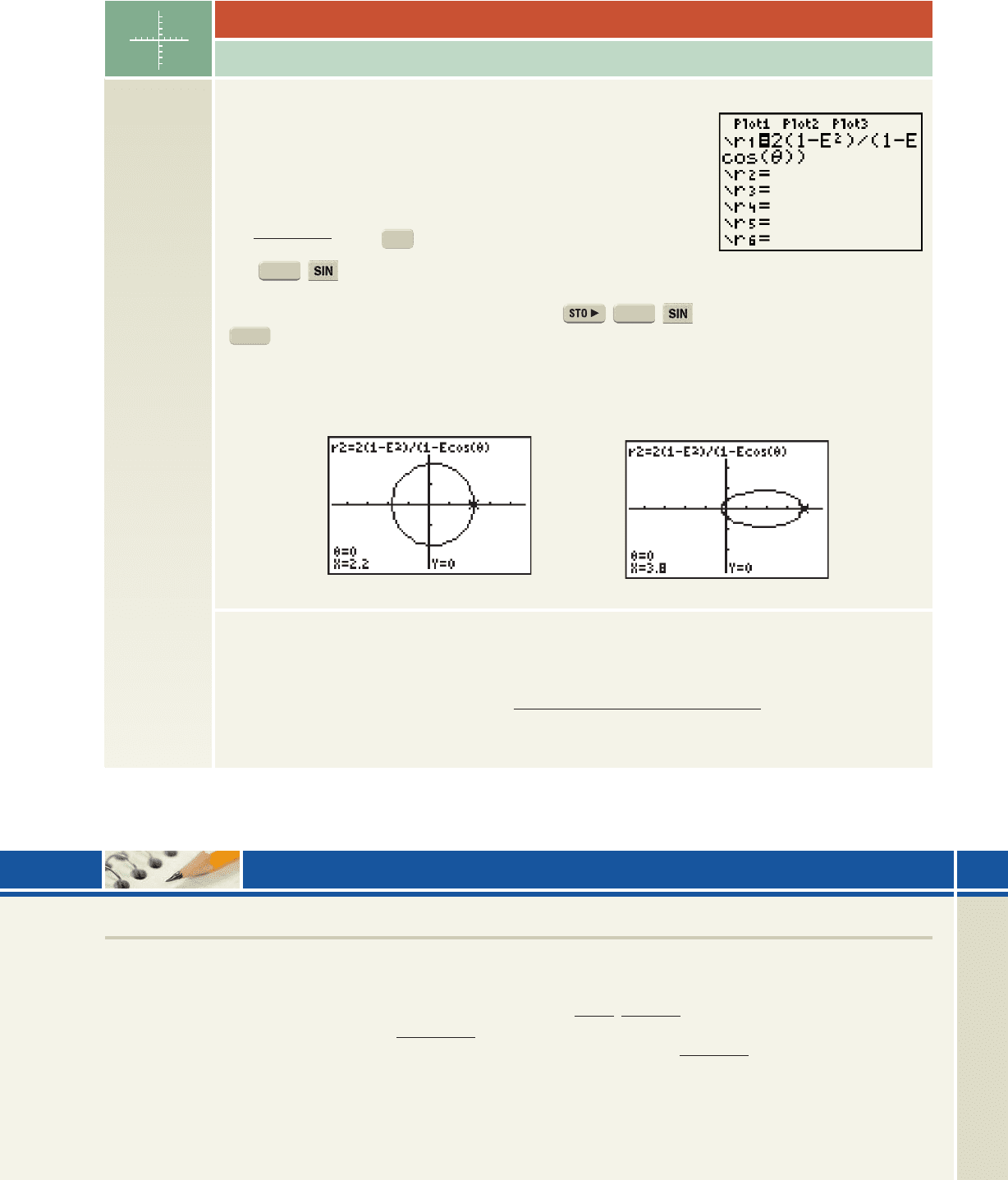
10-71 Section 10.6 More on the Conic Sections: Rotation of Axes and Polar Form 989
College Algebra & Trignometry—
Investigating the Eccentricity e
TECHNOLOGY HIGHLIGHT
One meaning of the word eccentric is “to deviate from a circular
pattern.” In a very real sense, this is the role that eccentricity plays as
it helps to describe the conic sections. For an ellipse we’ve learned
that If the eccentricity is near zero, there is little deviation
and the ellipse appears nearly circular. If e is near 1, the ellipse is very
elongated. To explore the eccentricity of an ellipse, enter the equation
on the screen, using (arbitrarily chosen)
and “E” for the eccentricity. The result is shown in Figure 10.58. We will enter and store
values for E on the home screen and graph the resulting ellipse (see Exercise 2 for an alternative
method). Return to the home screen and enter 0.1 and graph the result on the
4:ZDecimal screen. Repeat the procedure using 0.5, 0.75, and 0.9. The graphs for
and are shown in Figures 10.59 and 10.60. As you can see, when the ellipse is
nearly circular, while produces a graph that is cigar shaped.e 0.9
e 0.1e 0.9e 0.1
e 0.25,
ZOOM
ALPHA
ALPHA
a 2
Y =
r
a11 e
2
2
1 e cos
0 6 e 6 1.
Exercise 1: Try entering a value of then use your graphing calculator and basic knowledge to
verify the resulting graph is a circle.
Exercise 2: Try the same exercise using the set/list option. In other words, enter the equation as shown
here, with the values of e in braces { }: This will enable you to
view all five ellipses on the same \screen. Discuss the similarities and differences of this family of graphs.
r
1
211 50.1, 0.25, 0.5, 0.75, 0.96
2
2
11 50.1, 0.25, 0.5, 0.75, 0.96cos122
.
e 0,
3
5
3
5
3
5
3
5
Figure 10.58
Figure 10.59 Figure 10.60
10.6 EXERCISES
CONCEPTS AND VOCABULARY
Fill in each blank with the appropriate word or phrase.
Carefully reread the section if needed.
1. The set of points (x, y) in the xy-plane are related to
points (X, Y) in the XY-plane by the
formulas. To find the angle
between the original axes and the rotated axes, we
use .
tan122
.
cob19529_ch10_0979-0994.qxd 12/6/08 12:50 AM Page 989 epg HD 049 :Desktop Folder:Satya 05/12/08:
